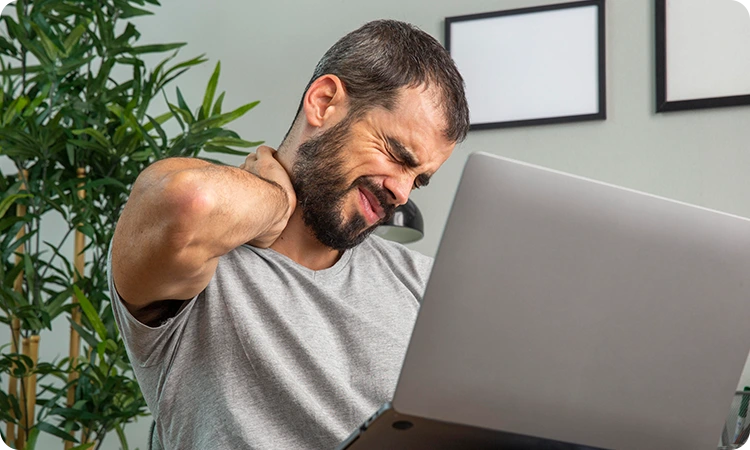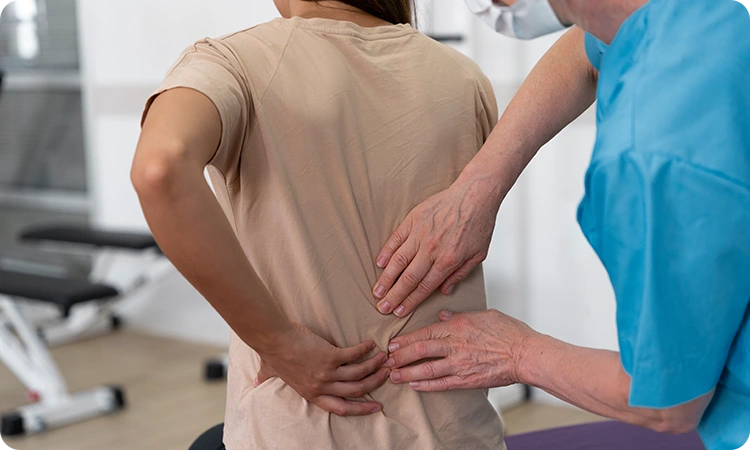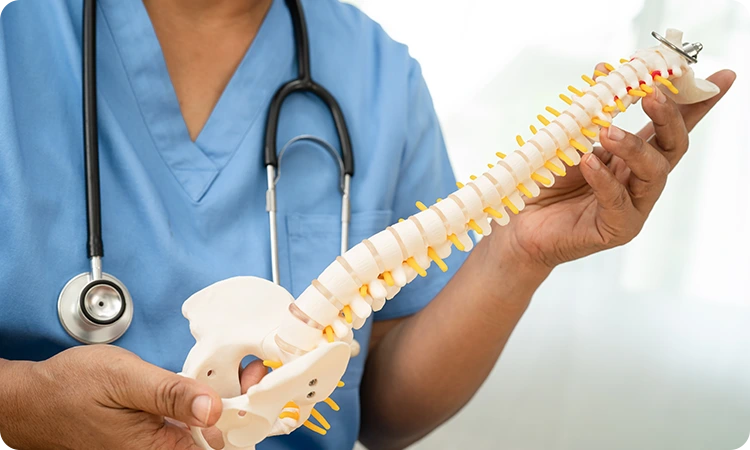Neck & Back Pain
Neck & Back Pain Treatment in Dubai
Neck Pain & Low Back Pain

Neck Pain & Low Back Pain are the commonest health problems of office workers. In the office, natural movements are restricted and movements, which the body parts are unused to, are forced to perform continuously, causing tension build ups. Tension build up results in muscles becoming tensed, sore and tender. The shoulder, neck, low back and upper back are the main tension collecting areas for most people. Repetitive strain injury (RSI) sometimes called occupational overuse syndrome, is also a growing problem among office workers. Don’t think that there is a perfect working position; the human body is designed to move, not to sit still. So, it’s important to make sure that you constantly use different parts of the body. It is simply not possible to use a keyboard for sixty hours a week without damaging your health, so try and find ways of getting away from the computer in between.
Neck Pain treatment in Dubai & Low Back Pain treatment in Dubai can also be caused due to Injuries, Muscle strains, Nerve compression, cervical spondylosis, Rheumatoid arthritis etc. You should seek immediate medical care if you experience, shooting pain or numbness into the legs or shoulder or down your arm.
Dr. Shyam’s Ayurveda Clinic in Dubai is your trusted destination for effective neck pain treatment and low back pain treatment. Our skilled practitioners utilize Ayurvedic techniques and personalized therapies to address the root causes of pain, providing holistic solutions that promote healing, mobility, and overall well-being.
Ayurveda treatment for neck pain and back pain
Treatment Tips:
- Keep the back comfortably straight – not to let the lower back sag or the head stay bent forward
- Make sure your forearms are roughly horizontal so that the desk supports them
- Don’t allow movements to become too focused; stretch regularly
- Change the relative positions of keyboard and screen regularly. For example, look left in the morning and right in the afternoon
- Get a telephone headset if you’re on the phone a lot. Use a chair with head rest and give relax for the neck muscles in between.
- Adjust your desk, chair and computer so the monitor is at eye level. Knees should be slightly lower than hips. Use the chair’s armrests.
- When pain hits, stop what you are doing and ease gently into a comfortable position.
- Drink plenty of quality water. Rest on a firm bed.
- Try lying face down on the floor, hands by your sides, this takes the pressure off your back.
- Once the acute pain has subsided, muscle strengthening will help to prevent recurrences.
- Don’t do any bending, twisting or lifting.
- When sitting, keep your knees a little higher than your hips and keep your feet flat on the floor.
- Always push large objects; never pull them.
- Move around. Do not sit in the same position for long periods of time.
- Practice Yoga postures like Bhujangasana, Salabhasana, Pavana muktasana.
Neck & Back Pain Treatment in Dubai
Cervical spondylosis & Lumbar Spondylosis

- Spondyl = spinal
- Olysis = with a hole” or with a crack
Cervical spondylosis and Lumbar spondylosis is a general term for age-related wear and tear affecting the joints in your neck. Also known as cervical osteoarthritis, this condition usually appears in people older than 40 and progresses with age. By age 60, 70% of women and 85% of men show changes consistent with Lumbar spondylosis and cervical spondylosis on x-ray. Pain in the neck or low back is common and may be a natural consequence of aging in people over 50. Like the rest of the body, bones in the neck & low back progressively degenerate as we grow older. Over time, arthritis of the neck & low back (spondylosis) may result from bony spurs and problems with ligaments and disks. The spinal canal may narrow (stenosis) and compress the spinal cord and nerves to the arms. When lumbar or cervical spondylosis develops in a teenager, it is almost always secondary to a predisposing abnormality in one of the joints between the vertebrae, probably as a result of previous mild trauma or another medical condition. Ankylosing spondylitis is another condition which a cause early spondylosis changes in your spine. The symptoms of Ankylosing spondylitis may include pain and stiffness in your lower back and hips, especially in the morning and after periods of inactivity. People who have a gene HLA-B27 are at increased risk.
The pain that results may range from mild discomfort to severe, crippling dysfunction. A previous neck injury can predispose to spondylosis, but the major risk factor is aging. An X ray, CT/MRI, EMG etc will reveal the severity of the condition. The goal of treatment is relief of pain and prevention of permanent spinal cord and nerve root injury.
Treatment Tips:
For mild low back pain and neck pain or stiffness, follow these suggestions:
- Take daily long, hot showers
- Take over-the-counter pain relievers
- Wear a cervical collar (which you can buy in a drugstore) during the day
- Regularly walk or engage in low-impact aerobic activity
- Medicines like Gugguluthikthakam, Yogaraja guggulu, maharasnadi kashayam etc. on prescription will be beneficial for you. Contact our Ayurveda doctor in person.
- Neck stretching and external application of Ayurvedic oils can give symptomatic pain relief.
Neck & Back Pain Treatment in Dubai
Disc Herniation

Inter vertebral Discs act as cushions between the vertebrae in our spine. Sometimes, the soft material inside a disk may bulge out of place or rupture and press on a nerve. But even so, many people who have bulging or herniated disks experience no pain from the condition. If a bulging or herniated disk press on the main nerve that travels down your leg, it can cause sciatica – sharp, shooting pain through the buttock and back of the leg. Ayurveda consider this as a Vata disease; treatment objectives are to balance Vata and thereby alleviate pain symptoms and prevent further degenerative changes of discs & vertebrae.
Treatment Tips:
Below mentioned therapies (as sessions of 7 / 14 / 21 days) are major parts of Ayurveda approach which are Vata balancing & back strengthening.
- Abhyanga: Trained experts’ massage lukewarm Ayurvedic oil on the body. Care should be taken to avoid pressure massage on low back region.
- Kizhi: This is the application & massage with warm roasted herbal bags dipped in Ayurvedic oils. This is very good for relieving spasm and stiffness; pains & aches also strengthen the spinal muscles.
- Pizhichil: This is a therapy in which the body is made to perspire by continuously pouring lukewarm herbal oils in a peculiar pattern followed by a gentle massage.
- Kadi Vasthy: Therapy in which lukewarm oil is allowed to stay on the low back for 30 – 45 minutes in a dam made with dough.
The right therapy & right oil; coupled with internal medications shall be chosen by the Ayurveda doctor after a detailed consultation / examination of the patient. In severe & chronic cases the below panchakarma therapies are also suggested: Vasthy (Enema with medicated liquids), Virechanam (Purgation therapy), Nasyam (Medicated oils as nasal drops)
Neck & Back Pain Treatment in Dubai
Spinal Stenosis

Spinal stenosis is a narrowing of one or more areas in your spine — most often in your neck or lower back. The spinal cord extends till the level of the first or second lumbar vertebra. Below that level, the vertebral canal is occupied by spinal nerve roots and meninges. Compressed nerves in your lower (lumbar) spine can cause pain or cramping in your legs when you stand for long periods of time or when you walk. The discomfort usually eases when you bend forward or sit down. Many different types of problems can cause lumbar canal stenosis. The most common of these problems are related to degeneration and the aging process like osteoarthritis, disk degeneration and thickened ligaments.
Treatment Tips:
- In Ayurveda, this disease is said to be caused due to the imbalance of Vata. Appropriate treatments to bring Vata back to normal treats the disease.
- The therapies like Abyangam, Pathrapotala swedam, Choornapinda swedam, Pizhichil, Kativasthy, Navarakizhi, Vasti (Kashaya and Anuvasana) etc. are done as per the stage & severity of the condition. These therapies are directed towards relieving the inflammatory changes; releasing the spasms and nerve compressions in the affected area, maintain the flexibility & stability of spine, controlling pain, strengthening the supportive tissues holding the spine/joints, nourishing the joints through improving the circulation, preventing further degenerative changes.
- Internal medications like Rasna Saptakam kashayam, Rasnerendadi kashayam, Sahacharadi kashayam, Gandharvahasthadi kashayam etc. on a prescription is very useful. Please call our Ayurveda center in UAE.
Neck & Back Pain Treatment in Dubai
Sciatica

Our spinal disk is like a jelly donut, with a softer center encased within a tough coating. Slipped disk or ruptured disk or herniated disk occurs when the softer jelly pushes out through a crack in the tough case. It can irritate nearby nerves and result in pain, numbness or weakness in arms or legs. As we age, our spinal disks lose some of their water content. That makes them less flexible and more prone to rupturing with even a minor twist. Sometimes, a traumatic event or lifting heavy objects can lead to a herniated disk. Herniated disks are most common in middle ages. Excess body weight causes extra stress on the disks in your lower back. Repetitive lifting, pulling, pushing, bending sideways and twisting also may increase your risk of a herniated disk. But even so, many people who have bulging or herniated disks experience no pain from the condition.
If a bulging or herniated disk press on the sciatic nerve that travels down your leg, it can cause sciatica — sharp, shooting pain through the buttocks, thighs, knees, and calves and to the ankles and toes. Many people get better in a month or two with conservative treatment. Imaging studies show that the protruding portion of the disk shrinks over time, corresponding to the improvement in symptoms. Muscle strengthening through exercise helps stabilize and support the spine. Ayurveda consider this as a Vata disease namely Gridhrasi; treatment objectives are to balance Vata and thereby alleviate pain symptoms and prevent further degenerative changes of discs & vertebrae. The right therapy & right oil; coupled with internal medications shall be chosen by our Ayurveda doctor after a detailed consultation and examination of the patient.
Treatment Tips:
Ayurveda offers an extensive list of therapies:
- Lepanam: Application of herbal pastes over the affected area which relieves pain and swelling
- Bandages: Bandages with herbal oils like Murivenna, Karpooradi thailam are effective
- Kadivasthy: Retention of warm oil in the low back with the aid of a dam made with dough
- Elakkizhi & Podikkizhi: warm herbal bags relieve pain and strengthen spinal muscles
In severe & chronic cases panchakarma therapies – Vasthy (Enema with medicated liquids), Virechanam (Purgation therapy), Nasyam (Medicated oils as nasal drops) are also suggested. Self-care measures can help a lot in the prevention and treatment of low back pain. Once the acute pain subsides, muscle strengthening will help to prevent recurrences. Don’t do any bending, twisting or lifting. Keep your knees a little higher than your hips and keep your feet flat on the floor while sitting in a chair. Do not sit in the same position for long periods of time. If you are a nursing mother, don’t strain your back by bending over your infant. Practice Yoga postures like Bhujangasana, Salabhasana, Pavana muktasana.
Dr. Shyam’s Ayurveda Clinics in Dubai / Ajman offers an extensive list of therapies mentioned as below:
- Lepanam: Application of herbal pastes over the affected area which relieves pain and swelling
- Bandages: Bandages with herbal oils are effective in Muscular pains
- Kadivasthy / Greeva vasthy: Retention of warm oil is very effective
- Elakkizhi & Podikkizhi: Warm herbal bags sweep pain away and strengthen spinal muscles
- Virechanam: Purgation therapy
- Vasthy: Enema therapy
- Nasya: Medicated nasal drops are very effective in Shoulder & Neck pains
Dr. Shyam’s Ayurveda in UAE has the panel of best Ayurveda doctors in Dubai and in Ajman under the leadership of Dr. V.L Shyam.
